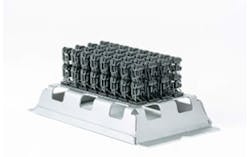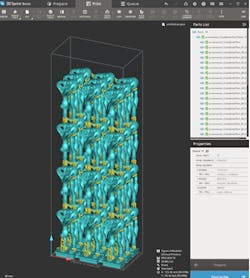Sponsored by 3D Systems
Additive manufacturing (AM) is evolving beyond prototyping to enable end-use parts production across a range of applications. Much has changed to enable this, including the development of AM processes and materials that are capable of meeting manufacturers’ standards for repeatability, reliability, accuracy, surface finish, and more. While traditional manufacturing methods continue to offer more affordable cost models at higher quantities, additive manufacturing offers greater supply chain flexibility and a strong solution for low-volume and bridge manufacturing, not to mention mass customization.
New Levels of Productivity in 3D Printing
Figure 4® Industrial Stacking
This new feature helps users take advantage of the full build height (350 mm) of the Figure 4 printer and offers new efficiency across the board, from setting up the job, to 3D printing, to post-processing. When the Figure 4 stacked manufacturing solution was evaluated for batch manufacturing at Decathlon, the world’s largest sporting goods retailer, Decathlon reduced print preparation time by as much as 80-percent. According to Decathlon materials engineer Gregoire Mercusot: “By stacking parts we are able to print in batches of 100, and have reduced the time it takes to prepare a build from 30 to 60 minutes to just six to 10 minutes.”
Pinpoint-contact strut support structures make high-density stacking automation compatible, allowing for quick support removal without manual labor. This means that in addition to increasing the number of parts produced per print, there is a decrease in labor time, enabling an overall lower cost per part.
While traditional manufacturing modes are likely to be used for the highest production volumes, advances in production-grade photopolymer materials, technology, and software have made AM economically viable for manufacturers that require significant quantities of initial series production, post-series production, and spare parts production. This technology is also making it possible for manufacturers to increase the depth and flexibility of their production process, even as they are delivering parts with greater cost efficiency.
3D Systems offers application-specific support through its Application Innovation Group to further facilitate this shift in capability. Combined with its advanced hardware, software, and materials, their deep industry expertise helps manufacturers maximize the benefits of AM to innovate better and faster than ever before.


